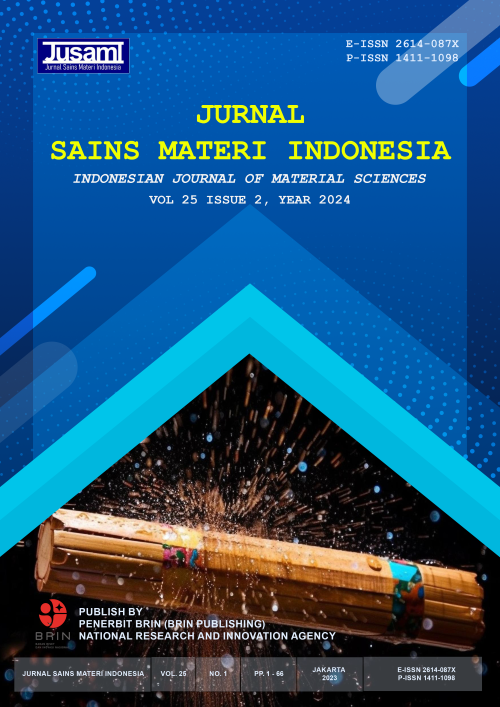Effect of Precursor Solvent on the Carbon Micro-Structures Derived from Spray Pyrolysis of Pine Resin (Gondorukem): Preliminary Study
DOI:
https://doi.org/10.55981/jsmi.2024.893Keywords:
Carbon, Microstructures, Microstructures Pine resin (gondorukem), Spray PyrolysisAbstract
Carbon materials have been widely used in various fields. This study aimed to produce carbon using spray pyrolysis with pine resin (gondorukem) as the precursor and different solvents, namely gondorukem-acetone (GAC), gondorukem-ethyl acetate (GEA), and gondorukem-dichloromethane (GDC). The precursor was prepared in a 1:8 (m/v) ratio, and the spray pyrolysis method was employed by heating the atomized precursor solution in the heating zone of a tube furnace. The atomization precursor was infused with nitrogen gas at a rate of 1 l/min with furnace temperature set at 1000°C with heating times of 5, 10, and 20 mins. The carbonaceous materials produced from the pyrolysis were collected on the wire mesh 1000 that was put on a stainless pipe. Carbon that has been coated on the wire mesh 1000 was analyzed using the optical microscope (OM). The physical properties and morphology of the synthesized carbonaceous material were analyzed using field emission scanning electron microscopy (FE-SEM), Fourier-transform infrared spectroscopy (FTIR), Raman, and Brunaur-Emmett-Teller (BET). Based on FE-SEM analysis, the particle size of the GAC sample has an average of 283.58 nm and the highest carbon content, which reached an average of 97.312 At%. GAC samples had the lowest disorder properties in the Raman spectroscopy test, with the value of ID/IG reaching 0.795764. The functional groups observed were C–H stretching at 2920.49 cm-1, N–H bending at 1629.07 cm-1, and C–O stretching at 1159.70 cm-1. Based on carbon content, disorder properties, and functional group stabilization, carbon from the GAC precursor provides the ideal characteristics to be used as a filter material in medical masks. Meanwhile, based on BET testing, the carbon materials from GEA have the ideal material morphological properties to be used as a filter in medical masks. Spray pyrolysis is an efficient method for producing carbon materials, and the use of gondorukem as the precursor shows great potential for various applications.
Downloads
References
M. Yang, C. Fang, J. Su, Y. Cheng, Q. Zhang, and M. Liu. “Synthesis mechanism of carbon microsphere from waste office paper via hydrothermal method.” BioReources, vol. 17, no. 4, pp. 5568–5577, 2022.
C. Li, J. Yang, L. Zhang, S. Li, Y. Yuan, X. Xiao, X. Fan, and C. Song. “Carbon-based membrane materials and applications in water and wastewater treatment: A review.” Environ. Chem. Lett., vol. 19, pp. 1457–1475, 2020.
S. Jiang, Q. Chen, J. Lin, G. Liao, T. Shi, and L. Qian. “Thermal stress-induced fabrication of carbon micro/nanostructures and the application in high-performance enzyme-free glucose sensors.” Sens. Actuators B. Chem., vol. 345, p. 130364, 2021.
P. Yu, W. Tang, F. -F. Wu, C. Zhang, H. -Y. Luo, H. Liu, and Z. -G. Wang. “Recent progress in plant-derived hard carbon anode materials for sodium-ion batteries: A review.” Rare Met., vol. 39, no. 9, pp. 1019–1033, 2020.
B. A. Alshammari, A. N. Wilkinson, B. M. Alotaibi, and M. F. Alotibi. “Influence of carbon micro-and nano-fillers on the viscoelastic properties of polyethylene terephthalate.” Polymers (Basel), vol. 14, no. 12, 2022.
E. Antolini. “Carbon supports for low-temperature fuel cell catalysts.” Applied Catalysis B: Environmental, vol. 88, no. 1–2. pp. 1–24, 2009.
U. Kamran, Y. J. Heo, J. W. Lee, and S. J. Park. “Functionalized carbon materials for electronic devices: A review,” Micromachines (Basel), vol. 10, no. 4, pp. 1–26, 2019.
J. Leng, Z. Wang, J. Wang, H. H. Wu, G. Yan, X. Li, H. Guo, Y. Liu, Q. Zhang, and Z. Guo. “Advances in nanostructures fabricated via spray pyrolysis and their applications in energy storage and conversion.” Chem. Soc. Rev., vol. 48, no. 11, pp. 3015–3072, 2019.
N. Saito, Y. Usui, K. Aoki, N. Narita, M. Shimizu, K. Hara, N. Ogiwara, K. Nakamura, N. Ishigaki, H. Kato, S. Taruta, and M. Endo. “Carbon nanotubes: Biomaterial applications.” Chem. Soc. Rev., vol. 38, no. 7, pp. 1897–1903, 2009.
S. Y. Lim, W. Shen, and Z. Gao. “Carbon quantum dots and their applications.” Chem. Soc. Rev., vol. 44, no. 1, pp. 362–381, 2015.
A. Sharma and J. Das. “Small molecules derived carbon dots: Synthesis and applications in sensing, catalysis, imaging, and biomedicine.” Journal of Nanobiotechnology, vol. 17, no. 92, 2019.
J. Li, Z. Xu, L. Yu, and L. Zhang. “Preparation of hundred-micron carbon spheres using solvent extraction in a simple microchannel device.” Microporous and Mesoporous Materials, vol. 343, p. 112186, 2022.
Q. Wang, F. Cao, Q. Chen, and C. Chen. “Preparation of carbon micro-spheres by hydrothermal treatment of methylcellulose sol.” Material Letters, vol. 59, no. 28, pp. 3738–3741, 2005.
S. Ratchahat, N. Viriya-empikul, K. Faungnawakij, T. Charinpanitkul, A. Soottitantawat. "Synthesis of carbon microspheres from starch by hydrothermal process." Sci. J. UBU, vol.1, no. 2, pp. 40-45, 2010.
K. G. Latham, I. Kozyatnyk, J. Figueira, M. Carlborg, E. Rosenbaum, and S. Jansson, “Self-generation of low ash carbon microspheres from the hydrothermal supernatant of anaerobic digestate: Formation insights and supercapacitor performance.” Chemical Engineering Journal Advances, vol. 6, p. 100097, 2021.
D. L. Sivadas, R. Narasimman, R. Rajeev, K. Prabhakaran, and K. N. Ninan. “Solvothermal synthesis of microporous superhydrophobic carbon with tunable morphology from natural cotton for carbon dioxide and organic solvent removal applications.” J. Mater. Chem. A, vol. 3, no. 31, pp. 16213–16221, 2015.
A. Bazargan, Y. Yan, C. W. Hui, and G. McKay. “A review: Synthesis of carbon-based nano and micro materials by high temperature and high pressure.” Industrial and Engineering Chemistry Research, vol. 52, no. 36. pp. 12689–12702, 2013.
J. K. Kim, Y. Yoo, and Y. C. Kang. “Scalable green synthesis of hierarchically porous carbon microspheres by spray pyrolysis for high-performance supercapacitors.” Chemical Engineering Journal, vol. 382, p. 122805, 2020.
Y. Wang and A. Hu. “Carbon quantum dots: Synthesis, properties and applications.” J. Mater. Chem. C, vol. 2, pp. 6921–6939, 2014.
L. Ndlwana, N. Raleie, K. M. Dimpe, H. F. Ogutu, E. O. Oseghe, M. M. Motsa, T. A. M. Msagati, and B. B. Mamba. “Sustainable hydrothermal and solvothermal synthesis of advanced carbon materials in multidimensional applications: A review.” Materials, vol. 14, no. 17, 2021.
S. E. Skrabalak, “Ultrasound-assisted synthesis of carbon materials.” Physical Chemistry Chemical Physics, vol. 11, no. 25, pp. 4930–4942, 2009.
D. S. Jung, S. Bin Park, and Y. C. Kang. “Design of particles by spray pyrolysis and recent progress in its application.” Korean Journal of Chemical Engineering, vol. 27, no. 6, pp. 1621–1645, 2010.
M. I. Ionescu, Y. Zhang, R. Li, X. Sun, H. Abou-Rachid, and L. S. Lussier, “Hydrogen-free spray pyrolysis chemical vapor deposition method for the carbon nanotube growth: Parametric studies.” Appl. Surf. Sci., vol. 257, no. 15, pp. 6843–6849, 2011.
M. U. Zahid, E. Pervaiz, A. Hussain, M. I. Shahzad, and M. B. K. Niazi. “Synthesis of carbon nanomaterials from different pyrolysis techniques: A review.” Mater. Res. Express, vol. 5, no. 5, 2018.
A. Darabont, P. Nemes–Incze, K. Kertesz, L. Tapaszto, A. A. Koos, Z. Osvath, Zs. Sarkozi, Z. Vertesy, Z. E. Horvath, and L. P. Biro. “Synthesis of carbon nanotubes by spray pyrolysis and their investigation by electron microscopy.” Journal of Optoelectronics and Advanced Materials, vol. 7, no. 2, pp. 631–636, 2005.
J. Lara-Romero, T. Ocampo-Macias, R. Martínez-Suarez, R. Rangel-Segura, J. López-Tinoco, F. Paraguay-Delgado, G. Alonso-Nuñez, S. Jiménez-Sandoval, and F. Chiñas-Castillo. “Parametric study of the synthesis of carbon nanotubes by spray pyrolysis of a biorenewable feedstock: α-pinene.” ACS Sustain. Chem. Eng., vol. 5, no. 5, pp. 3890–3896, 2017.
A. V. Melezhik, M. A. Smykov, E. Yu. Filatova, A. V. Shuklinov, R. A. Stolyarov, I. S. Larionova, and A. G. Tkachov. “Synthesis of carbon nanotubes from acetone.” Theoretical Foundations of Chemical Engineering, vol. 47, no. 4, pp. 435–443, Jul. 2013.
Z. Xue, Y. Shen, P. Li, Y. Zhang, Y. Zeng, and S. Zhu. “Controllable synthesis of carbon nanotubes via autothermal reforming of ethyl acetate.” Mater. Des., vol. 141, pp. 150–158, 2018.
A. Li, J. Wang, K. Zhang, W. Fu, L. Cheng, Dr. M. Zhang. “Preparation of porous carbon from dichloromethane and p-phenylenediamine with short KOH activation depth.” Chem. Electro Chem., vol. 9, no. 10, p. e202200190, 2022.
R. A. Afre, T. Soga, T. Jibo, M. Kumar, Y. Ando, M. Sharon, P. R. Somani, M. Umeno. “Carbon nanotubes by spray pyrolysis of turpentine oil at different temperatures and their studies,” Microporous and Mesoporous Materials, vol. 96, no. 1–3, pp. 184–190, 2006.
Perum Perhutani, “Laporan Tahunan Perum Perhutani Tahun 2018,” Jakarta, Indonesia, 2018.
M. de la Garza, I. López, and I. Gómez. “In situ synthesis and deposition of gold nanoparticles with different morphologies on glass and ITO substrate by ultrasonic spray pyrolysis.” Advances in Materials Science and Engineering, vol. 2013, 2013.
E. Brimas, R. Skaudžius, G. Brimas, A. Selskis, R. Ramanauskas, and A. Kareiva. “Three different techniques to reconstruct 3D view of SEM images by using only free available software.” CHEMIJA, vol. 33, no. 1, pp. 7–11, 2022.
J. Jeevanandam, A. Barhoum, Y. S. Chan, A. Dufresne, and M. K. Danquah. “Review on nanoparticles and nanostructured materials: History, sources, toxicity and regulations.” Beilstein J. of Nanotechnol., vol. 9, no. 1, pp. 1050–1074, 2018.
C. Sisu, R. Iordanescu, V. Stanciu, I. Stefanescu, A. M. Vlaicu, and V. V. Grecu. “Raman spectroscopy studies of some carbon molecular sieves.” Dig. J. Nanomater. Biostruct., vol. 11, no. 2, pp. 435–442, 2016.
M. S. Dresselhaus, A. Jorio, A. G. Souza Filho, and R. Saito. “Defect characterization in graphene and carbon nanotubes using Raman spectroscopy.” Phil. Trans. R. Soc. A, vol. 368, no. 1932, pp. 5355–5377, 2010.
S. Osswald and Y. Gogotsi. “In Situ Raman Spectroscopy of Oxidation of Carbon Nanomaterials,” in Raman Spectroscopy for Nanomaterials Characterization, Springer Nature, 2012, pp. 291–351.
P. Puech, M. Kandara, G. Paredes, L. Moulin, E. Wiss-Hortala, A. Kundu, N. Ratel-Ramond, J. -M. Plewa, R. Pellenq, and M. Monthioux. “Analyzing the raman spectra of graphenic carbon materials from kerogens to nanotubes: What type of information can be extracted from defect bands?” Journal of Carbon Research, vol. 5, no. 4, p. 69, 2019.
V. Ţucureanu, A. Matei, and A. M. Avram. “FTIR spectroscopy for carbon family study.” Crit. Rev. Anal. Chem., vol. 46, no. 6, pp. 502–520, 2016.
J. Zhuang, M. Li, Y. Pu, A. J. Ragauskas, and C. G. Yoo. “Observation of potential contaminants in processed biomass using fourier transform infrared spectroscopy.” Appl. Sci, vol. 10, no. 12, pp. 1–13, 2020.
J. Sukprasert, K. Thumanu, I. Phung-on, C. Jirarungsatean, L. E. Erickson, P. Tuitemwong, and K. Tuitemwong. “Synchrotron FTIR light reveals signal changes of biofunctionalized magnetic nanoparticle attachment on salmonella sp.,” J. Nanomater., vol. 2020, 2020.
D. S. Volkov, P. K. Krivoshein, and M. A. Proskurnin. “Detonation nanodiamonds: A comparison study by photoacoustic, diffuse reflectance, and attenuated total reflection FTIR spectroscopies.” Nanomaterials, vol. 10, no. 12, pp. 1–37, 2020.
G. Sdanghi, R. L. S. Canevesi, A. Celzard, M. Thommes, and V. Fierro. “Characterization of carbon materials for hydrogen storage and compression.” C—Journal of Carbon Research, vol. 6, no. 3, p. 46, 2020.
M. Maryam, A. B. Suriani, M. S. Shamsudin, and M. Rusop, “BET analysis on carbon nanotubes: Comparison between single and double stage thermal CVD method.” Adv. Mat. Res., vol. 626, pp. 289–293, 2013.
W. K. Essa, S. A. Yasin, I. A. Saeed, and G. A. M. Ali. “Nanofiber-based face masks and respirators as COVID-19 protection : A review.” Membranes, vol. 11, no. 4, p. 250, 2021.
Downloads
Published
How to Cite
Issue
Section
License
Copyright (c) 2024 Jayadi, Wahyu Bambang Widayatno, Agus Sukarto Wismogroho, Cherly Firdharini, Akhiruddin Maddu, Husin Alatas, Yessie Widya Sari

This work is licensed under a Creative Commons Attribution-ShareAlike 4.0 International License.








